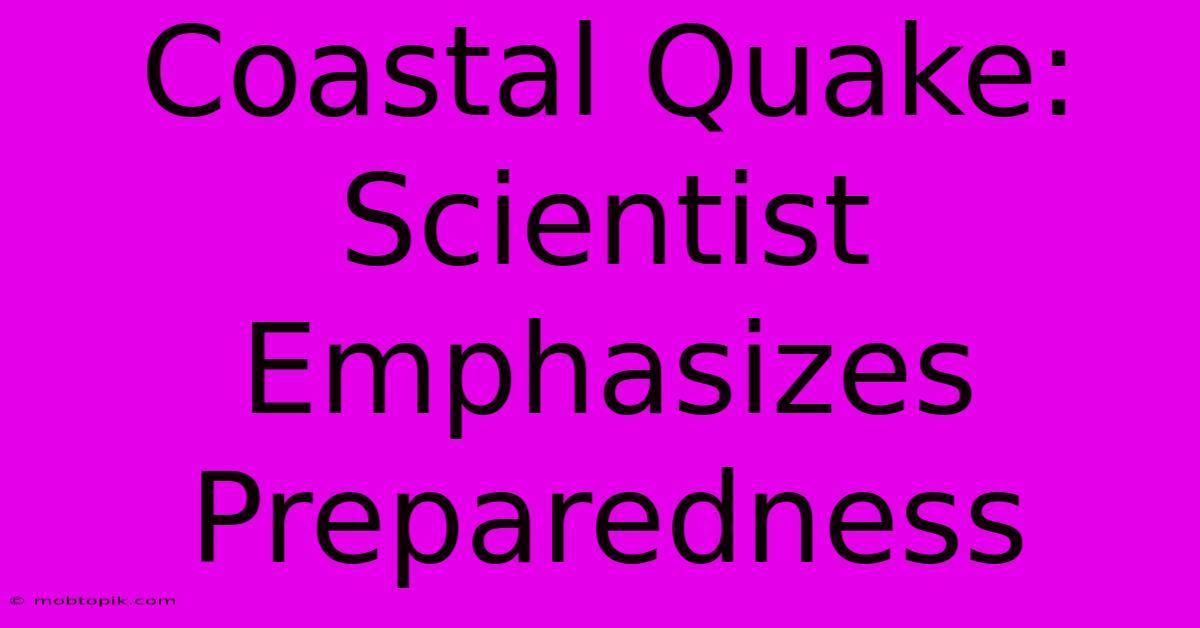Coastal Quake: Scientist Emphasizes Preparedness

Discover more detailed and exciting information on our website. Click the link below to start your adventure: Visit Best Website mobtopik.com. Don't miss out!
Table of Contents
Coastal Quake: Scientist Emphasizes Preparedness
The earth groans, the sea roars, and the ground trembles. A coastal earthquake is a terrifying prospect, a confluence of natural disasters that can unleash devastation on a scale few can imagine. While we can't prevent earthquakes, we can prepare. This is the urgent message from leading seismologist Dr. Evelyn Reed, who recently concluded a series of lectures emphasizing the crucial need for coastal communities to bolster their earthquake preparedness strategies. Dr. Reed’s research and decades of experience highlight a sobering truth: coastal regions face unique and amplified threats during seismic events.
The Unique Dangers of Coastal Earthquakes
Coastal earthquakes pose a more significant threat than inland quakes due to several interacting factors:
1. Tsunamis: The Devastating Wave
The most immediate and often devastating consequence of a coastal earthquake is the potential for a tsunami. These massive waves, generated by underwater seismic activity, can travel at incredible speeds, inundating coastal areas with destructive force. The warning time can be minimal, leaving communities with little opportunity to evacuate. Dr. Reed stresses the importance of understanding local tsunami evacuation routes and the significance of heeding official warnings. Knowing your elevation and having a pre-determined evacuation plan is paramount.
2. Liquefaction: The Treacherous Ground
Coastal areas often contain loose, saturated sediments. During an earthquake, these sediments can lose their strength, transforming into a fluid-like substance – a process known as liquefaction. Buildings and infrastructure built on liquefiable soils can sink, tilt, or even collapse completely. This phenomenon significantly increases the risk of damage and casualties. Dr. Reed highlights the need for stricter building codes in coastal zones, incorporating designs that are resistant to liquefaction. Investing in geotechnical surveys to assess soil conditions before construction is crucial.
3. Ground Shaking and Structural Damage: Amplified Destruction
The intensity of ground shaking can be amplified in coastal areas due to the geological characteristics of the region. The presence of soft sediments and proximity to the ocean can magnify seismic waves, leading to more severe structural damage. Dr. Reed emphasizes the necessity of retrofitting older buildings to withstand stronger ground motion. Regular inspections and seismic upgrades are vital for ensuring the safety of existing structures.
4. Secondary Hazards: Cascading Disasters
Coastal earthquakes often trigger a cascade of secondary hazards, compounding the devastation. These can include landslides, which are particularly prevalent in hilly coastal regions; fires, often sparked by damaged gas lines; and widespread power outages, disrupting essential services. Developing comprehensive emergency plans that account for these secondary hazards is essential for effective disaster response.
Preparing for the Inevitable: A Comprehensive Approach
Dr. Reed's research underscores the need for a multi-faceted approach to coastal earthquake preparedness. This includes:
1. Individual Preparedness: Personal Responsibility
Develop a family emergency plan: This should include evacuation routes, communication strategies, meeting points, and an emergency supply kit containing essential items like water, food, first-aid supplies, and a battery-powered radio. Regularly practice your evacuation plan.
Learn CPR and first aid: Being able to provide immediate assistance could save lives in the aftermath of an earthquake.
Secure your home: Identify potential hazards and take steps to secure them. This includes anchoring heavy objects, bracing shelves, and reinforcing weak points in your structure.
2. Community Preparedness: Collective Action
Participate in community earthquake drills: These drills help familiarize residents with evacuation procedures and emergency response strategies.
Volunteer for your local emergency response team: Your skills and time can be invaluable in a disaster.
Support local initiatives to strengthen infrastructure: Advocating for stronger building codes and seismic upgrades is crucial for protecting your community.
3. Government Preparedness: Systemic Resilience
Invest in early warning systems: Improved tsunami warning systems and seismic monitoring networks can provide critical time for evacuation.
Enforce strict building codes: Coastal building codes must reflect the unique challenges posed by earthquakes and tsunamis.
Develop comprehensive emergency response plans: These plans should be regularly reviewed and updated to account for evolving threats and technological advancements.
Fund research and development: Continued research into earthquake prediction and mitigation is essential for enhancing preparedness efforts.
Beyond the Immediate Aftermath: Long-Term Recovery
The recovery process following a major coastal earthquake can be prolonged and complex. Dr. Reed emphasizes the importance of psychological preparedness, acknowledging the significant emotional toll that such disasters can take on individuals and communities. Building strong social networks and access to mental health resources are crucial for long-term recovery. Planning for post-disaster housing, essential services, and economic recovery is also vital for ensuring the long-term resilience of coastal communities.
Conclusion: A Call to Action
Coastal earthquakes represent a significant and growing threat. However, by adopting a comprehensive approach to preparedness—at the individual, community, and governmental levels—we can significantly reduce the devastating consequences of these events. Dr. Reed’s message is clear: preparedness is not just about survival; it’s about resilience. It's about safeguarding lives, protecting livelihoods, and ensuring the future of our coastal communities. The time to act is now. Don't wait for the next quake to strike; prepare today. Your life, and the lives of those around you, may depend on it.

Thank you for visiting our website wich cover about Coastal Quake: Scientist Emphasizes Preparedness. We hope the information provided has been useful to you. Feel free to contact us if you have any questions or need further assistance. See you next time and dont miss to bookmark.
Also read the following articles
| Article Title | Date |
|---|---|
| Nz Vs Sl 3rd Odi | Jan 11, 2025 |
| Aston Villa Vs West Ham Fa Cup Result | Jan 11, 2025 |
| 28 14 Win Ohio State Vs Texas Jan 10 2025 | Jan 11, 2025 |
| Raetselhafter Post Kloeckner Loescht Ihn | Jan 11, 2025 |
| No 6 Buckeyes Hard Fought Game | Jan 11, 2025 |
